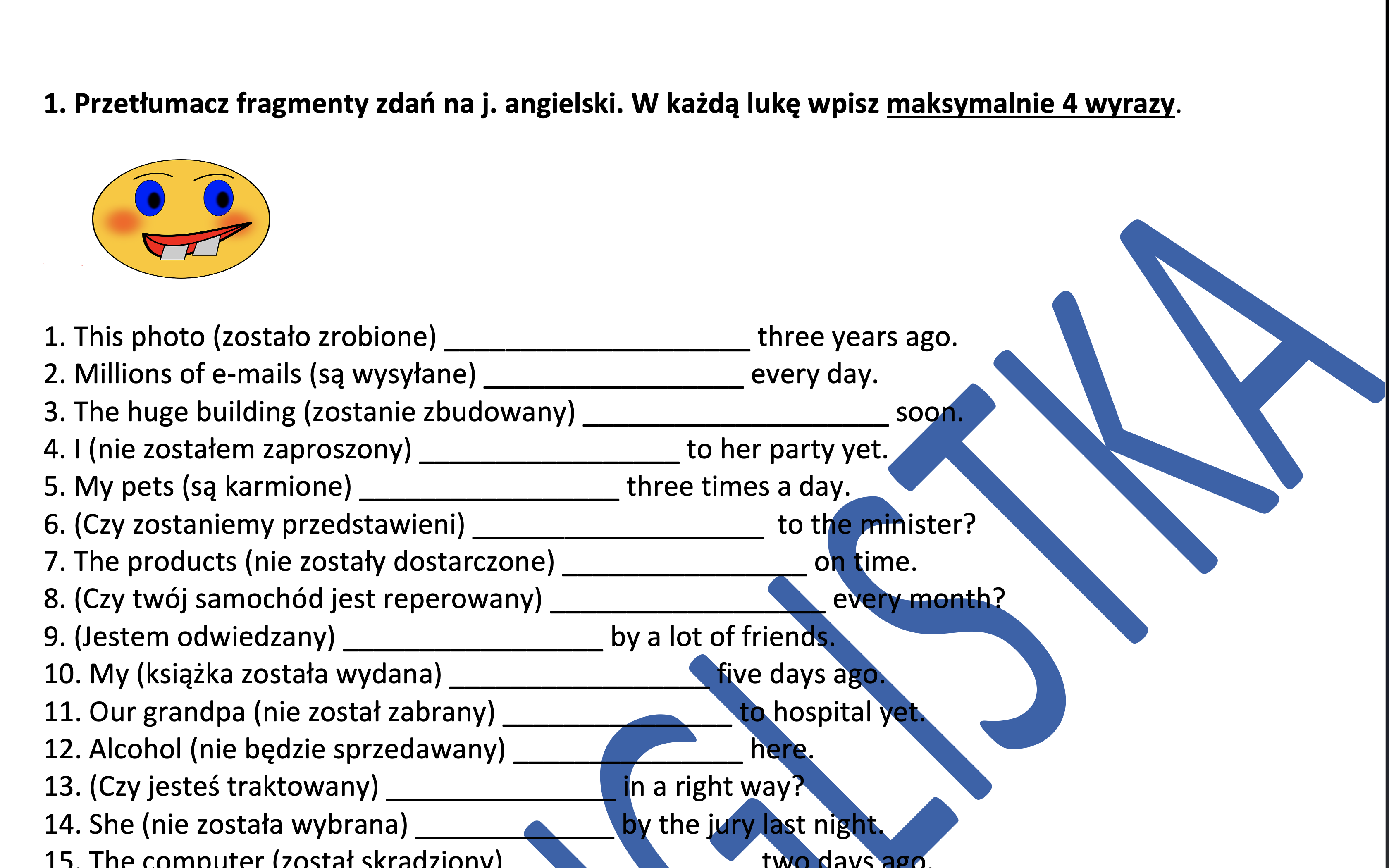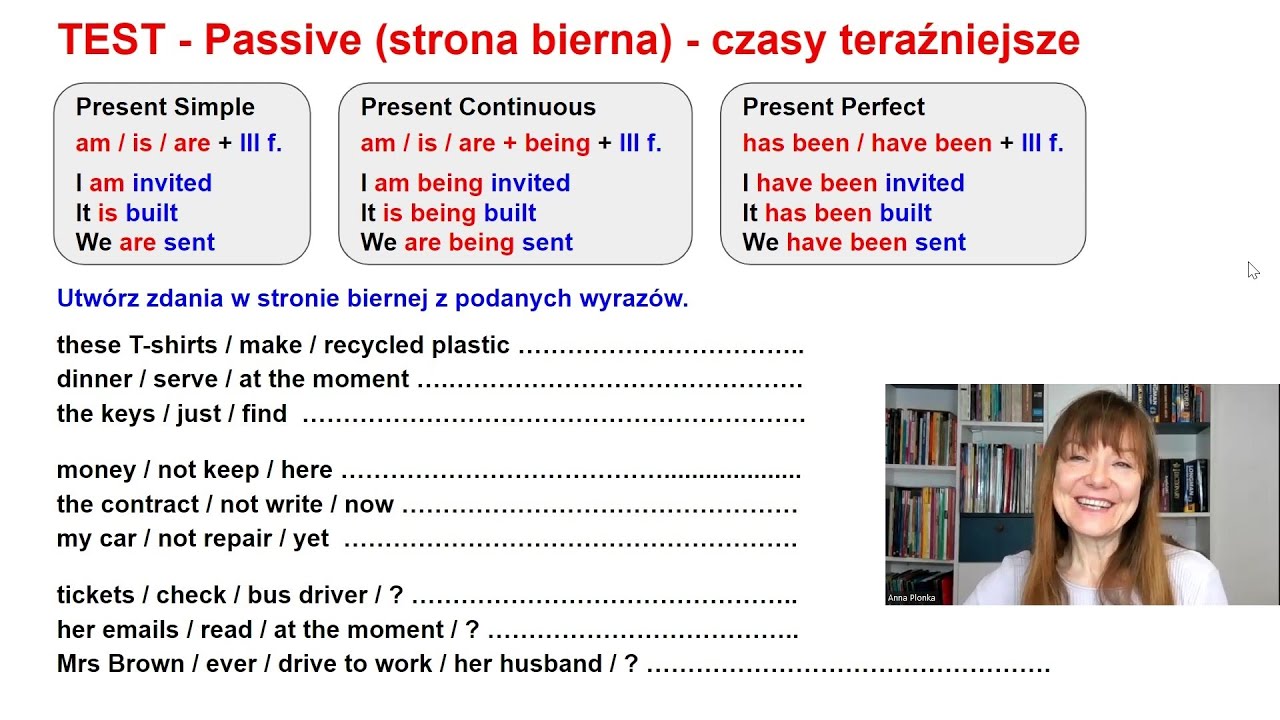Hej! Gotowi na powtórkę z Strony Biernej w Present Simple?
To bardzo ważny temat. Zaraz wszystko dokładnie omówimy. Zaczynamy!
Co to jest Strona Bierna w Present Simple?
Strona bierna (Passive Voice) to konstrukcja gramatyczna. Zmienia perspektywę zdania.
Zamiast skupiać się na wykonawcy czynności, skupiamy się na samej czynności i jej odbiorcy.
W Present Simple używamy jej do opisywania faktów, rutynowych czynności lub ogólnych prawd.
Jak tworzymy Stronę Bierną w Present Simple?
Formuła jest prosta:
Podmiot (odbiorca czynności) + is/am/are + Past Participle (III forma czasownika)
Np. The letter is written by John.
Użycie 'is', 'am', 'are'
Pamiętaj o poprawnej formie czasownika "to be":
- is – dla podmiotów w liczbie pojedynczej (np. he, she, it, the book)
- am – tylko dla podmiotu "I"
- are – dla podmiotów w liczbie mnogiej (np. we, you, they, the books)
Past Participle (III forma czasownika)
Tutaj musisz znać formy czasowników. Szczególnie te nieregularne.
Dla czasowników regularnych dodajemy końcówkę -ed. Np. played, watched, cleaned.
Dla czasowników nieregularnych... Trzeba się ich nauczyć! Np. written, spoken, eaten.
Przykłady zdań w Stronie Biernej (Present Simple)
Spójrzmy na kilka przykładów. To pomoże Ci zrozumieć:
- Aktywna: They clean the rooms every day.
- Bierna: The rooms are cleaned every day.
- Aktywna: She writes a letter.
- Bierna: A letter is written by her.
- Aktywna: I make breakfast.
- Bierna: Breakfast is made by me.
- Aktywna: People speak English here.
- Bierna: English is spoken here.
Kiedy używamy Strony Biernej?
Używamy jej, gdy:
- Wykonawca czynności jest nieznany lub nieważny.
- Chcemy podkreślić samą czynność lub jej odbiorcę.
- Jest to bardziej formalne i obiektywne.
Ćwiczenia!
Teraz czas na ćwiczenia. To najlepszy sposób na naukę.
Ćwiczenie 1: Przekształć zdania na stronę bierną.
Spróbuj przekształcić te zdania na stronę bierną. Użyj Present Simple.
- The chef cooks dinner.
- The students learn English.
- The postman delivers the mail.
- The children play football.
- She sings a song.
Ćwiczenie 2: Uzupełnij luki.
Uzupełnij zdania odpowiednią formą czasownika w stronie biernej (Present Simple).
- The car ______ (wash) every week.
- The flowers ______ (water) by the gardener.
- The dishes ______ (do) after dinner.
- The house ______ (clean) on Saturdays.
- The books ______ (read) by many people.
Ćwiczenie 3: Popraw błędy.
Znajdź i popraw błędy w tych zdaniach:
- The cake is bake by my mother.
- English are speak all over the world.
- The letter am written by him.
- The rooms is clean every day.
- Breakfast are made by me.
Odpowiedzi do ćwiczeń:
Ćwiczenie 1:
- Dinner is cooked by the chef.
- English is learned by the students.
- The mail is delivered by the postman.
- Football is played by the children.
- A song is sung by her.
Ćwiczenie 2:
- The car is washed every week.
- The flowers are watered by the gardener.
- The dishes are done after dinner.
- The house is cleaned on Saturdays.
- The books are read by many people.
Ćwiczenie 3:
- The cake is baked by my mother.
- English is spoken all over the world.
- The letter is written by him.
- The rooms are cleaned every day.
- Breakfast is made by me.
Podsumowanie:
Pamiętaj:
- Strona bierna (Passive Voice) skupia się na czynności i jej odbiorcy, a nie na wykonawcy.
- W Present Simple tworzymy ją za pomocą: is/am/are + Past Participle.
- Używamy jej, gdy wykonawca jest nieznany, nieważny lub chcemy coś podkreślić.
Dobra robota! Mam nadzieję, że to pomogło. Powodzenia na egzaminie!

